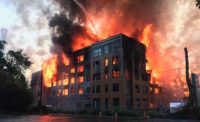Architects and structural-steel, concrete and masonry interests fighting the “wood first” movement are breathing a collective sigh of relief since Oregon legislators adjourned for the year on June 30 without enacting legislation that would give wood a leg up over other framing materials for use in public buildings.


Wood interests say they are not going to take their defeat—the latest in a string of setbacks in the Oregon and Washington state capitals—lying down.
“We plan to resubmit the same or similar legislation in [Oregon's 2012] legislative session,” says Linc Cannon, director of forest resources and taxation, Oregon Forest Industries Council, Salem.
The failed or tabled bills in Olympia and Salem varied, but all gave wood preferential treatment in public buildings. The last bill introduced in Salem said a state project “must use structural wood products to the extent feasible.”
“We successfully blocked attempts by the timber industry to create laws designed to give them an unfair advantage,” says Ross Allbritton, Northwest marketing representative for the American Institute of Steel Construction, Chicago.
The wood-first movement started in British Columbia, Canada, when, in 2009, provincial legislators enacted laws that, among other things, gave wood preferential treatment in public buildings.
The non-profit WoodWorks for Non-residential Construction says it is pushing wood-first bills not just to increase wood's market share, which was 19.4% in the U.S. in 2010, but because wood is nature's greenest and most renewable building material.
Others see a different picture. “A fair-practice approach … open to all industries is a much better method for achieving objectives related to life-cycle cost, sustainability, energy conservation and other selection criteria,” says Bob Thomas, president of the National Concrete Masonry Association. Thomas also is concerned about the U.S. Dept. of Agriculture's announcement that it plans to preferentially select wood in new U.S. Forest Service construction.
Stan L. Bowman, executive director of the American Institute of Architects Northwest and Pacific Region, says his group opposes wood-first bills: “Selection of building materials should be left to the architect and their client based on performance and other design considerations.”
Stephen V. Skalko, manager of regional code services for the Portland Cement Association, Skokie, Ill., says wood frames may not always stack up as sustainable, especially because they are more susceptible to fire damage during construction. “How green are buildings that must be built twice even before they are occupied?” asks Skalko, referring to a May 3 blaze that destroyed a six-story residential complex, called Remy, under construction near Vancouver, B.C.









Post a comment to this article
Report Abusive Comment